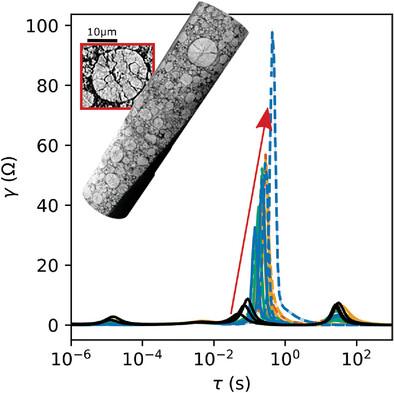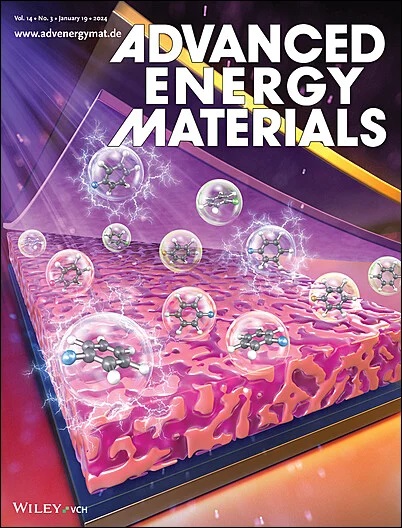IF 24.4
1区 材料科学
Q1 CHEMISTRY, PHYSICAL
引用次数: 0
摘要
从电动汽车中回收锂离子电池对于降低成本和支持国内电池供应链的发展至关重要。与传统回收技术相比,镍钴锰酸锂(NMC)等正极的直接回收具有低成本、低能耗和低排放的特点,因此很有吸引力。然而,需要全面了解报废时活性材料的特性,以指导直接回收工艺和性能相关的再利用应用。在此,我们对报废商业袋式电池中的 NMC 材料进行了表征,并与未循环利用的原始材料在容量、阻抗、晶体学、形态学和微观结构方面进行了对比,以确定主要降解模式并了解报废材料的可变性。此外,还对整个电池中每种特性的空间异质性进行了量化。虽然降解材料显示出与原始材料相似的容量,但其阻抗和速率能力却严重下降。此外,与从中心区域提取的样品相比,从电极层外围提取的样品表现出更严重的性能损失。性能损失的罪魁祸首是材料的微观结构,其中颗粒裂纹的大小与阻抗成分的相关性最强,而阻抗成分受到的影响最大。这项研究表明,阴极活性材料中的严重裂纹是直接再循环方法必须克服的主要挑战。本文章由计算机程序翻译,如有差异,请以英文原文为准。

Heterogeneity of the Dominant Causes of Performance Loss in End-of-Life Cathodes and Their Consequences for Direct Recycling
Recycling Li-ion batteries from electric vehicles is critical for reducing costs and supporting the development of a domestic battery supply chain. Direct recycling of cathodes, like LiNixMnyCozO2 (NMC), is attractive due to its low cost, energy use, and emissions compared to traditional recycling techniques. However, a comprehensive understanding of the active material properties at end-of-life is needed to guide direct recycling processes and the performance-dependent reuse applications. Here, NMC material from an end-of-life commercial pouch cell is characterized and bench-marked against pristine non-cycled counterparts with respect to capacity, impedance, crystallography, morphology, and microstructure to identify major degradation modes and understand variability in the end-of-life material. The spatial heterogeneity of each property throughout the cell is also quantified. While the degraded material demonstrated similar capacity as the pristine, its impedance and rate capability are severely diminished. Furthermore, samples from the periphery of the electrode layers showed more severe performance loss compared to samples extracted from central regions. The dominant culprit of performance loss is the material microstructure, where the magnitude of particle cracking showed the strongest correlation to the impedance components that are most unfavorably impacted. This work suggests severe cracks in cathode active materials are the primary challenge that direct recycling methods must overcome.
求助全文
通过发布文献求助,成功后即可免费获取论文全文。
去求助
来源期刊

Advanced Energy Materials
CHEMISTRY, PHYSICAL-ENERGY & FUELS
CiteScore
41.90
自引率
4.00%
发文量
889
审稿时长
1.4 months
期刊介绍:
Established in 2011, Advanced Energy Materials is an international, interdisciplinary, English-language journal that focuses on materials used in energy harvesting, conversion, and storage. It is regarded as a top-quality journal alongside Advanced Materials, Advanced Functional Materials, and Small.
With a 2022 Impact Factor of 27.8, Advanced Energy Materials is considered a prime source for the best energy-related research. The journal covers a wide range of topics in energy-related research, including organic and inorganic photovoltaics, batteries and supercapacitors, fuel cells, hydrogen generation and storage, thermoelectrics, water splitting and photocatalysis, solar fuels and thermosolar power, magnetocalorics, and piezoelectronics.
The readership of Advanced Energy Materials includes materials scientists, chemists, physicists, and engineers in both academia and industry. The journal is indexed in various databases and collections, such as Advanced Technologies & Aerospace Database, FIZ Karlsruhe, INSPEC (IET), Science Citation Index Expanded, Technology Collection, and Web of Science, among others.
 求助内容:
求助内容: 应助结果提醒方式:
应助结果提醒方式:


